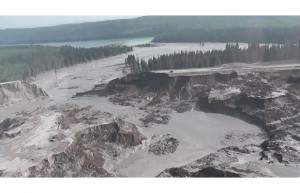(8/11/2014 Update: On August 8, 2014, Knight Piésold, Ltd. issue a statement indicating that it had ceased being the “Engineer of Record” for the Mount Polley Mine in 2011. You can click here to read this statement along with a letter the firm sent to Mount Polley leadership.)
The engineering firm that designed the tailings dam that collapsed on Monday Aug. 4 in British Columbia is playing a key role in the engineering of the tailings facility for Rosemont Copper Company’s proposed open-pit copper mine.

The tailings pond dam breach at the Mount Polley mine released an estimated 10 million cubic metres of water and 4.5 million cubic metres of fine sand into Polley Lake. Photograph: Vancouver Sun/Screen grab, Cariboo Regional District, YouTube
Knight Piésold Ltd., an international engineering and environmental services firm, has been the geotechnical engineering consultant for Imperial Metals’ Mount Polley tailings storage facility that released millions of cubic meters of tailings water into Hazeltine Creek, which empties into Quesnel Lake, about 370 miles north of Vancouver.
Knight Piésold has also conducted laboratory testing on materials that would be used in Rosemont’s proposed tailings facility. Knight Piésold conducted the analysis as a subcontractor for AMEC Earth & Environmental, Inc., which prepared the final design report for Rosemont’s dry stack tailings storage facility in April 2009.
AMEC also relied on Knight Piésold in 2010 to conduct analysis of soil materials that would be used in the Rosemont tailings facility in response to questions from the Arizona Department of Environmental Quality. ADEQ requested the additional testing after it determined that the previous “assessment of physical and engineering properties of the dry stack tailings…is inadequate.”
The cause of the collapse of the tailings dam at the Mount Polley mine near Likely, B.C. is under investigation. The B.C. Ministry of Environment says it warned Imperial Metals about the level of wastewater in the tailings pond at its Mount Polley mine repeatedly before this week’s devastating breach, according to the CBCNews.
The tailings water had failed provincial water quality guidelines for human and aquatic health in the past, according to the environment ministry and early Wednesday the Cariboo Regional District declared a state of local emergency, the National Post reported.
While the tailings facility design for the proposed Rosemont project is different than what was at Mount Polley, the issues concerning potential structural failure remain.
Rosemont, which is owned by Toronto-based Hudbay Minerals Inc., is planning to build the world’s largest “dry stack” tailings facility for its proposed $1.2 billion open-pit mine planned for the Santa Rita Mountains on the Coronado National Forest southeast of Tucson.
The use of so-called dry stack tailings facilities is a relatively new technology that uses filters to reduce the amount of moisture in the slurry of mine waste created by the milling process. Rosemont is proposing to use the dry stack facility to save water and reduce the “footprint” of the tailings because they can be compacted.
Despite the name, dry stack tailings are not devoid of moisture. Knight Piésold officials have stated that using the terms “dry stack” or “dewatered tailings” “should be avoided whenever possible, as such terms tend to give a false sense about the nature of the material since these materials typically still retain a significant amount of moisture.”
Knight Piésold had provided Imperial Metals with “design, technical specifications, contract documents, construction supervision and quality assurance/control, reviews of instrumentation and monitoring records and annual inspections” of the failed Mount Polley tailings facility, according to a 2004 Imperial Metal’s feasibility study filed with the British Columbia Securities Commission.
According to a 2007 article in the Canadian Institute of Mining, Metalurgy and Petroleum (CIM), Knight Piésold had been involved with the Mount Polley mine in central British Columbia since 1989 when the project was in the feasibility stage.
Knight Piésold provided all the detailed design and construction, quality assurance and quality control for the multiple tailings dam raises since construction began in 1996. The company also completed annual inspections of the tailings facility, and in 2006 provided the design for a heap leach pad, according to the CIM article.
The article noted that “water management” was important at the Mount Polley mine site because it was operating under water surplus conditions, with the water being stored in the tailings facility.
At the time of the 2oo7 article, CIM stated that Knight Piésold engineers were working with Mount Polley mine personnel to adapt the site water management plan so that it accommodates the ongoing expansion of the mine.

5 Responses to Engineering firm that designed collapsed BC mining waste dam is key player in Rosemont’s proposed tailings dump